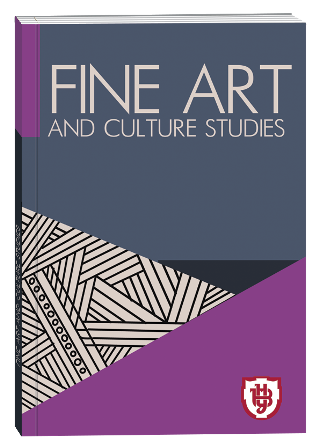FEATURES OF THE MUSICAL ETHOS OF THE MONOPHONIC LITURGY OF JOHN CHRYSOSTOM FROM THE PEREMYSHL MANUSCRIPT OF THE MID-17TH CENTURY
DOI:
https://doi.org/10.32782/facs-2023-1-10Keywords:
philosophy of music, modes, musical ethos, musical structures, monophonic liturgyAbstract
The article presents a philosophical and musical research of the ethos of certain parts of the monophonic Liturgy of John Chrysostom from the Peremyshl manuscript of the mid-seventeenth century, namely: The Cherubic Song, the Eucharistic Canon, and the Song of Praise in honor of the Saint Mary «Axion estin» by analyzing the elements of their complex musical structures. The author describes a number of musical forms of these structures. Through them the ethos of the monophonic Liturgy is revealed. It is found that the work uses all types of modes that Plato and Aristotle called ethical. The connection between semantic and musical structures is revealed. Musical phrases corresponding to certain word-symbols reflect the spirit expressed by the ethos of musical modes. It has been determined that the interweaving of the Doric (1, 1, ½) masculine with the Lydian (½, 1, 1) mournful feminine mode in the form of "question" and "answer" takes the form of a series of binary oppositions. It is also found that the last phrase of the Cherubic Song ends with a joyful (according to Plato) Phrygian mode (1, ½, 1), which carries purification and expresses the state of an «ecstatically excited soul» (according to Aristotle). The functions of musical forms are emphasized in view of the conceptual principles of classification of the musical ethos of Plato and Aristotle. The main elements of the complex structure are distinguished: Lydian, Phrygian, Dorian modes, which harmoniously are combined with each other. It is noted that, given the prospects of combining the achievements of the classics of ancient philosophy with the latest methodological approaches, further research should be aimed at establishing deeper interconnections between the doctrine of musical ethos and modern musicological and musicological-philosophical concepts. Based on the study of the musical text of the monophonic liturgy, it is concluded that the method of structural analysis of musical forms is a promising approach for the philosophical and musical comprehension of the ethos of sacred compositions.
References
Балуцька Н. М. Літургія Йоана Златоустого з Перемишльського ірмолоя. / Молоде музикознавство. Наукові збірки Львівської національної музичної академії ім. М. В. Лисенка. Вип. 20. Львів : Сполом, 2008. С. 128–134.
Драганчук, В. М. Музична психологія і терапія: навч. посіб. для студ. спец. «Музичне мистецтво» / В. Драганчук; передм. Л. Кияновської. Східноєвр. нац. ун-т ім. Лесі Українки, 2016. 230 с.
Каблова Т.Б. Музичний етос епохи Середньовіччя. Вісник Національної академії керівних кадрів культури і мистецтв . 2019. №2. С. 379–381.
Літургія Йоана Златоустого з Перемишльського рукопису середини XVII століття / упор. Н. Балуцька, Н. Сиротинська; ред. Кр. Ганнік і Ю. Ясіновський / Інститут Літургійних Наук Українського Католицького Університету, Lehrstuhl für Slavische Philologie der Bayerischen Julius-Maximilian Universität zu Würzburg [=Антологія
візантійськослов’янської церковної монодії, 7]. Львів: в-во УКУ, 2008. 23 с.
Мішин В.Ю. Вчення про музичний етос у класичну епоху. Молодий вчений. 2018. №2. С. 537– 542.
Назаров Н.А . Алгебраїчні моделі симетрії балтослов’янських фольклорних текстів. Folia Philologica. 2021. №1. С. 34–54.
Назаров, Н.А. Індоєвропейський музичний ідіом та етногенез індоєвропейців. Folia Philologica, 2021. №2. С. 42–60.
Нємцова Л.О. Історія окремих напрямів музичного мистецтва в Україні у ХХ столітті. Вісник Національної академії керівних кадрів культури і мистецтв. 2021. №4. С. 150–155.
Сізова Н.С., Білозерська Г.О. Системний підхід та структурний метод як основа дослідження регіональної хорової культури. Педагогічні науки. 2021. № 151. С. 176–184.
Чжун Т. Інформаційно-діяльнісний компонент формування емоційної стійкості в музично-виконавській діяльності учнів дитячої музичної школи. Педагогічні науки: теорія та практика. 2022. №4. С. 186–190.
Asano R. The evolution of hierarchical structure building capacity for language and music: a bottom-up perspective. Primates. 2022. №63. P. 417–428.
Bodily P. M. & Ventura D. Inferring Structural Constraints in Musical Sequences via Multiple Self-Alignment. Proceedings of the Annual Meeting of the Cognitive Sciense Society. 2021. P. 43.
Godøy R. Constraint-Based Sound-Motion Objects in Music Performance. Frontiers in Psychology. 2021. P. 1–17.
Mankel K., Shrestha U., Tipirneni-Sajja A., Bidelman G.M. Functional Plasticity Coupled With Structural Predispositions in Auditory Cortex Shape Successful Music Category Learning. Front. Neurosci. 2022. Vol. 16:897239







